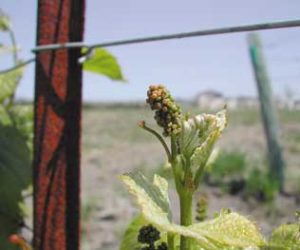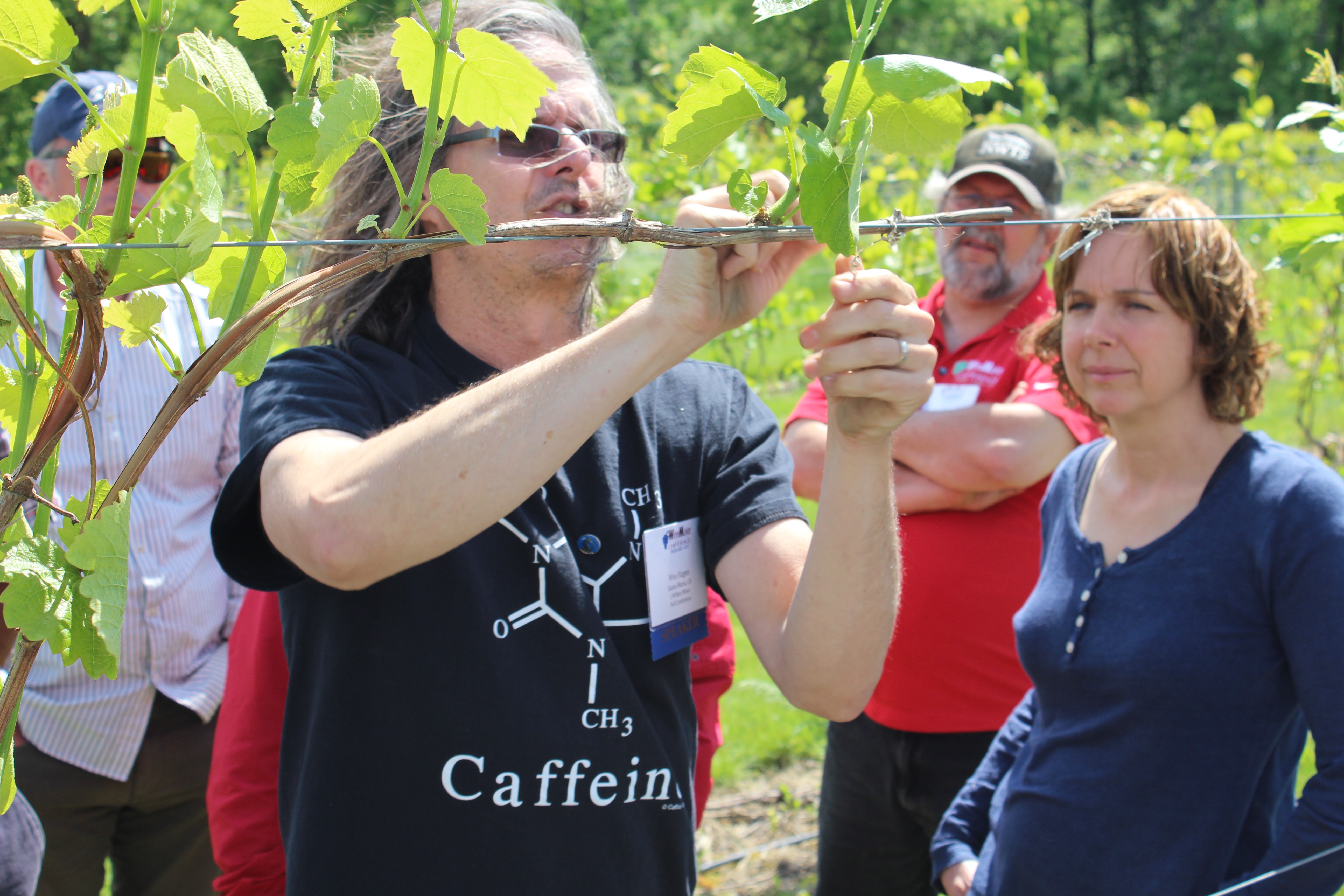
A lesson that I’ve learned in the wine growing and winemaking business is that there’s always something to do to make the vines healthier, make the crop more intense and to keep the wine clean so that it will express the place where it was grown.
The purpose of this article is simple: To discuss ways to improve wine quality in the vineyard.
It’s summer, and the vegetative growing cycle of the shoots and leaves is slowing. Sugar is beginning to accumulate in the berries via photosynthesis. The grapes are going through veráison (or berry softening). Before you know it, harvest will arrive. The key to success is to consider your viticultural practices (what you do to the vines) and discover how you can improve the 2001 vintage while it’s still hanging in the vineyard. Correlating information about last year’s farming with the quality of last year’s wine is critical. I’d like to look at four issues of wine quality and suggest some viticultural practices and winemaking techniques that will address them specifically. Many of these questions and concerns have come directly from the WineMaker readership. These types of exchanges are vital for understanding how vineyard management affects wine quality.
Keep in mind that no other kind of farming is as site-specific as viticulture! As always, I recommend searching out the best local winegrape growers and winemakers in your specific locale for further tips and clarification. Bring them some good wine and they will remember the gesture next time you call them in the middle of the night to describe a terrible downy-mildew nightmare.
Problem: My wine always smells like sulfur or rotten eggs during fermentation and sometimes after.
Solution: Your problem may be too much elemental sulfur in the must. Elemental sulfur can become hydrogen sulfide during fermentation, which can stink like rotten eggs and might require some splash-racking and copper sulfate (1 percent solution) to fix. Hydrogen sulfide can also come from finicky yeast strains or too little nitrogen in the must or juice — which can be fixed by adding some yeast nutrient or DAP (diammonium phosphate) prior to inoculating the juice or must.
If the wine stinks like sulfur, where did it come from? Most likely it came from spraying sulfur on the vines to keep mildew and rot in check over the growing season. There are a few things you can do. Carefully apply lime sulfur or horticultural oil to your dormant vines next year to kill any spores that might be “overwintering” in or on the wood of the vine. Then use copper early in the season in combination with sulfur to knock down sporulating mildew before it becomes a problem. This may mean early-season sulfur applications every week. Use a strong solution of sulfur early in the season, keep the vines clean and fungi-free up to veráison and don’t spray sulfur on the grapes after veráison.
In my vineyard I use no sulfur after berry set. Instead I use products like Kaligreen (potassium bicarbonate) or a synthetic called Flint (check with your local USDA extension office about local permits that would enable you to purchase Flint) that lasts almost 20 days between applications. Other than switching to a synthetic fungicide, be very careful to use enough sulfur to keep the grapes clean early, and then use as little sulfur as possible after berry set, and none once the grapes have softened. I’ve heard of some winemakers washing the berries off the day before they’re to be picked, and I can’t see how that would hurt if you believe there is some residual sulfur on the grapes.
Chances are, though, if there’s sulfur on the fruit at harvest, it’s already present in the juice and pulp of the grapes. The key to bringing in clean grapes and making clean wine is to keep sulfur applications limited after berry set, make sure the grapes are fully ripe and make sure your yeast has all the nitrogen and food it needs during primary fermentation. Using wettable sulfur before bloom and using dusting sulfur after that, might limit the amount of sulfur that ends up in the wine.
Problem: My wine lacks intensity and color.
Solution: Limit early season, pre-veráison watering, drop some crop (cut and remove the fruit while still green or remove the clusters that are behind and still hard after most of the fruit has softened) and try to get some sun flecks on the remaining fruit. Many varieties of winegrape vines are yield sensitive. This means that the more crop the vine has to ripen, the less intense, and perhaps less complex, the wine will become. A rule I try to follow is to keep the leaf-to-cluster ratio around 12 to 15:1. Try to keep vegetative growth in check by not giving the vines much water in their first few months of growth, or better yet, grow on infertile, sloped and rocky ground to keep the vines at low to moderate vigor.
Studies conducted by U.C. Davis on Oakville Cabernet showed that early season deficit irrigation (not giving the vines any water up to berry-softening) reduced cluster weight, increased color and made a more intense, colorful, higher-rated wine. A good rule to follow is to wait as long as you can before giving your vines water.
This will keep vegetative growth limited and keep your canopy open to wind and sun. With color, much of the color pigment in grapes (anthocyanin) is produced to protect the grapes from the sun. Think of getting sun on your grapes like trying to get a suntan. You don’t want them in the sun at all times. You want 10 to 40 percent ambient sunlight to filter through the canopy and touch the grapes. Measuring sunlight is not easy, but you can put a white piece of paper next to your fruit and see how much of the paper is “flecked” with light at any given time.
Continue removing leaves from around the fruit until the paper is about one-third covered with sun flecks. If you are growing grapes in a shaded canopy, the color of your wine will suffer. See the next solution for more on manipulating the canopy.
Problem: My wine has a vegetable smell like asparagus, green bell pepper or olives.
Solution: Your fruit is being grown in the shade and will continue to taste like this until you figure out a way to allow more sunlight to penetrate the leaf layers and fleck the fruit. There is a constituent in grapes called methoxypyrazine that smells just like a green bell pepper. The only way I know to get rid of pyrazines in the fruit is by sun exposure, which also increases the amount of floral and complex aromatics (monoterpenes) that will be present in the final wine.
The sun moves, as do the flecks of sun that touch the fruit. You might need to put some wires on your trellising that direct the shoot growth vertically so the fruit is a bit more exposed. For those without the means to accomplish a “vertical-shoot positioned” trellis system, or for those whose vines are so vigorous that the system would fail, try leaf removal. Remove as many leaves as necessary to give the vines at least 10 to 40 percent of the sunlight directly on the fruit. This is commonly done after the berries have set, when they are around the size of a pea. Caution: Watch the fruit carefully and make sure not to take off too many leaves, or your fruit will raisin and you will have no other choice but to make Amarone.
In my vineyard (in Lompoc, California), the weather is so cool that I can strip every leaf from the fruiting zone and get upwards of 70 percent ambient light on the fruit. But only 20 miles east of me, the same practice would raisin the crop. It’s up to you to figure out how much leaf plucking is appropriate and how it affects the flavor of the finished wine. Removing leaves will also help to increase air circulation in the canopy. This will make the vine more resistant to mildew, rot, disease and even some insects.
Problem: My wine lacks structure and tastes too “soft” or “flabby.”
Solution: Maybe you plan to take my advice and pick later this year. Well, you won’t be surprised that picking too late can be a big problem as well — the higher the sugars, the more alcohol, and it’s easy for the wine to become too “hot” if the grapes are overripe. When a wine accumulates sugar via photosynthesis, it continues to respire acid. So as the sugar goes up, acidity goes down. The goal of the viticulturist is to choose the perfect cool morning to pick the fruit, when the sugar will provide a potential alcohol of about 13 percent (about 24° Brix) and the acidity is in balance.
I like to pick white wines below 3.4 pH and red wines under 3.5 pH, knowing that the pH will go up at least a tenth of a point after primary fermentation. So if your wine is too “soft” and has no grip or refreshing zip, you may have to pick a little earlier or make a sensible acid addition. Remember that most winemakers believe that the earlier you make acid additions before or during fermentation (during crushing is a good time), the better the wine will taste. The best wines are made without having to adjust the must or juice at all.
It seems strange to me that grape growing and winemaking are seen in American wine culture as being separate entities. As you have learned from the solutions above, winemaking and winegrowing often overlap — they really are an extension of the same craft. Those intrepid souls that choose to grow and make their own wine will understand quickly the challenges and excitement inherent in creating a vintage from the ground up.
If American wine is going to compete with the best of Europe, we need to start focusing on viticultural techniques, such as limiting yield, opening up our canopies, allowing ambient sunlight to contact the fruit, picking on the perfect day and using early season deficit irrigation to limit the size of our vines’ growth. Wine is “made” in the vineyard. Taking the time to ensure perfect fruit will save you from having to fix the wine later on.




